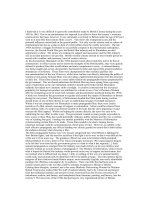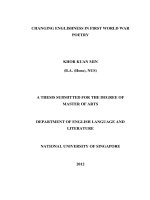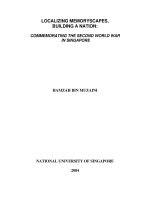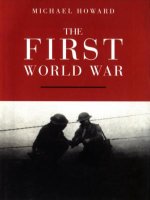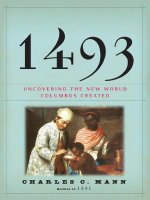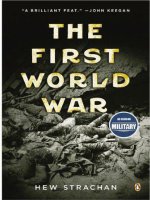Hew strachan the first world war (v5 0)
Bạn đang xem bản rút gọn của tài liệu. Xem và tải ngay bản đầy đủ của tài liệu tại đây (14.85 MB, 319 trang )
Table of Contents
ABOUT THE AUTHOR
Title Page
Copyright Page
Dedication
Introduction
Chapter 1 - TO ARMS
Chapter 2 - UNDER THE EAGLE
Chapter 3 - GLOBAL WAR
Chapter 4 - JIHAD
Chapter 5 - SHACKLED TO A CORPSE
Chapter 6 - BREAKING THE DEADLOCK
Chapter 7 - BLOCKADE
Chapter 8 - REVOLUTION
Chapter 9 - GERMANY’S LAST GAMBLE
Chapter 10 - WAR WITHOUT END
Acknowledgements
NOTES
INDEX
PHOTO CREDITS
FOR THE BEST IN PAPERBACKS, LOOK FOR THE
Praise for The First World War
“The Great War of 1914 — 1918 is increasingly and accurately regarded as the defining event of the
twentieth century. This is quite simply the best short history of the war in print. Strachan provides a
history of the war as a global conflict, waged for fundamental issues that continue to shape our
values, and the way we see the world. The governments, the societies, and the people who sacrificed
on scales barely imaginable today were not deluded players on a stage of shadows. Strachan has
emerged as the master of us all who write of war in English.”
— Dennis Showalter
“This is a powerful and highly readable account of the determining event of the twentieth century. The
many photographs are outstanding.”
— Paul Johnson
“What Strachan offers is history as only the professional can do it, and rarely enough even then. Every
intricacy, political, military, and diplomatic, of the conflict is open for inspection.”
— Adam Gopnik, The New Yorker
“A marvel of synthesis . . . This serious, compact survey of the war’s history stands out as the most
well-informed, accessible work available.”
— Los Angeles Times
“Splendid . . . the prose is so clear that the author’s fellow academics may revoke his numerous
honors.” — The Washington Post
“This is likely to be the most indispensable one-volume work on the subject since John Keegan’s
First World War.”
— Publishers Weekly
“A well-conceived and lucidly written survey of the twentieth century’s first great bloodletting, with
close attention to little-known episodes in and preceding the conflict . . . The best single-volume
treatment of the conflict in recent years.” — Kirkus Reviews
ABOUT THE AUTHOR
Hew Strachan is the Chichele Professor of the History of War and a fellow of All Souls College,
Oxford University. The editor of The Oxford History of the First World War , he is writing a threevolume history of the First World War, the first volume of which was published in 2001 to wide
acclaim. He lives in Scotland.
PENGUIN BOOKS
Published by the Penguin Group
Penguin Group (USA) Inc., 375 Hudson Street, New York, New York 10014, U.S.A.
Penguin Group (Canada), 90 Eglinton Avenue East, Suite 700, Toronto, Ontario,
Canada M 4P 2Y3 (a division of Pearson Penguin Canada Inc.)
Penguin Books Ltd, 80 Strand, London WC2R 0RL, England
Penguin Ireland, 25 St Stephen’s Green, Dublin 2, Ireland (a division of Penguin Books Ltd)
Penguin Group (Australia), 250 Camberwell Road, Camberwell,
Victoria 3124, Australia (a division of Pearson Australia Group Pty Ltd)
Penguin Books India Pvt Ltd, 11 Community Centre, Panchsheel Park,
New Delhi - 110 017, India
Penguin Group (NZ), 67 Apollo Drive, Rosedale, North Shore 0745,
Auckland, New Zealand (a division of Pearson New Zealand Ltd)
Penguin Books (South Africa) (Pty) Ltd, 24 Sturdee Avenue, Rosebank,
Johannesburg 2196, South Africa
Penguin Books Ltd, Registered Offices:
80 Strand, London WC2R 0RL, England
First published in the United States of America by Viking Penguin,
a member of Penguin Group (USA), Inc. 2004
Published in Penguin Books 2005
10 9
Copyright © Hew Strachan, 2003
All rights reserved
eISBN : 978-1-101-15341-3
1. World War, 1914 — 1918. I. Title.
D521.S86 2004
640.3 — dc22 2003062191
The scanning, uploading and distribution of this book via the Internet or via any other means without the permission of the publisher is illegal and punishable by law.
Please purchase only authorized electronic editions, and do not participate in or encourage electronic piracy of copyrighted materials. Your support of the author’s
rights is appreciated.
For Pamela and Mungo
Who may not have lived through the First World War but have had to live with it
INTRODUCTION
In Britain popular interest in the First World War runs at levels that surprise almost all other nations,
with the possible exception of France. The conclud ing series of Blackadder, the enormously
successful BBC satirization of the history of England, saw its heroes in the trenches. Its humour
assumed an audience familiar with château-bound generals, goofy staff officers and cynical but longsuffering infantrymen. The notion that British soldiers were ‘lions led by donkeys’ continues to
provoke a debate that has not lost its passion, even if it is now devoid of originality. For a war that
was global, it is a massively restricted vision: a conflict measured in yards of mud along a narrow
corridor of Flanders and northern France. It knows nothing of the Italian Alps or of the Masurian
lakes; it bypasses the continents of Africa and Asia; and it forgets the war’s other participants —
diplomats and sailors, politicians and labourers, women and children.
Casualty levels do not provide a satisfactory explanation for such insularity. British deaths in the
First World War may have exceeded those of the Second, and Britain is unusual, if not unique, in this
respect. The reverse is true for Germany and Russia, as it is for the United States. However, even
losses of three-quarters of a million proved to be little more than a blip in demographic terms. The
influenza epidemic that swept from Asia through Europe and America in 1918 — 19 killed more
people than the First World War. By the mid- 1920s the population of Britain, like those of other
belligerents, was recovering to its pre-war levels. In the crude statistics of rates of marriage and
reproduction there was no ‘lost generation’.
But the British, and particularly the better educated classes, believed there was. The legacy of
literature, and its effects on the shaping of memory, have proved far more influential than economic or
political realities. In 1961, Benjamin Britten incorporated nine poems by Wilfred Owen in his War
Requiem, which he dedicated to the memory of four friends who had been killed in 1939 — 45. The
work was first performed at the consecration of the Coventry Cathedral in 1962. The old cathedral
was a casualty of the Second World War, not the First, but Britten was following an established
pattern in conflating the commemoration of the two wars. Armistice Day for the First World War, 11
November 1918, and the act of remembrance on the nearest Sunday to it, was appropriated to honour
the dead of 1939-45. Today Remembrance Sunday embraces not only every subsequent war in which
Britain has been engaged but also more general reflections on war itself, and on its cost in blood and
suffering. The annual service at the Cenotaph in Whitehall is therefore deeply paradoxical. A
ceremony weighted with nationalism, attended by the Queen and orchestrated as a military parade,
bemoans wars fought in the nation’s name. It cuts away war’s triumphalism, and in the process seems
to question the necessity of the very conflicts in which those it commemorates met their deaths.
Wilfred Owen himself embodied some of these paradoxes. Owen was killed in action on 4
November 1918: his mother did not receive the news until after the fighting was over. The war both
did for Owen and made him. He returned to the front line when he could probably have avoided doing
so, telling his mentor, Siegfried Sassoon, ‘Serenity Shelley never dreamed of crowns me’. The war
gave him the material which transformed him into one of the greatest English poets of the twentieth
century. For schoolchildren throughout Britain his verses are often their first and most profound
encounter with the First World War. Niall Ferguson’s interpretation of the conflict, The Pity of War ,
published on the occasion of the armistice’s eightieth anniversary in 1998, used Owen’s words in its
title. But it is worth recalling what Owen makes explicit but his readers tend to overlook — that his
subject was war as a general phenomenon, more than the First World War in particular. Dulce et
decorum est pro patria mori, that ‘it is sweet and fitting to die for one’s country’, is, he insists, ‘an
old lie’. By quoting Horace, Owen places himself along a continuum that embraces two millennia; he
says little, if anything, about the peculiarities that explained the horrors of the war in which he himself
served and died.
Owen did not achieve canonical status until the 1960s: Britten popularised him. The first edition of
his poems, prepared by Sassoon in December 1920, sold 730 copies. A further 700 copies, printed in
1921, were still not sold out by 1929. By then the collected poems of another victim of the war,
Rupert Brooke, had run to 300,000 copies. Brooke knew his Horace as well as Owen did, but for
Brooke’s ‘The Soldier’ death in battle was both sweet and fitting. Of course Brooke’s continuing
popularity reflected in large measure the desire of wives and mothers, of parents and children, to find
solace in their mourning. They needed the reassurance that their loss was not vain. But it makes
another point — that the First World War was capable of many interpretations, and that until at least
the late 1920s those different meanings co-existed with each other. Every adult across Europe, and
many in Africa, Asia, the Americas and Australasia, had his or her own sense of the war’s
significance. The conviction that the war was both wasteful and futile was neither general nor even
dominant.
When the great powers of Europe embarked on war in 1914 popular conceptions of combat were
shaped more by the past than by prognostications of the future. The literature of warning, both popular
and professional, was abundant. But hope prevailed over realism, and in truth the circumstances of
the outbreak created little choice: for every nation the war seemed to be one of national self-defence,
and the obligations on its citizens were therefore irrefutable. By December 1916 the nature of the
war, its costs and casualties, and their threat of social upheaval, were self-evident. But even then
none of the belligerents seized the opportunity of negotiation which the United States held out. The
differences in values and ideologies look less stark than they seemed then only because we have been
hardened by the later clashes between Fascism and Bolshevism, and between both of them and
western liberalism. The very fact of the United States’s entry into the war in April 1917 makes the
point. Woodrow Wilson had been ‘too proud to fight’. He was deeply opposed to the use of war for
the furtherance of policy, and the evidence of the battles of Verdun and the Somme in 1916 should
have consolidated that belief. So when he took the United States into the war he laboured under few
illusions as to the horrors which men like Wilfred Owen had experienced at first hand. But he
concluded that the United States had to wage war if it was to shape the future of international
relations. It may have been a vision which the Senate rejected in the war’s immediate aftermath, but it
still inspires American foreign policy.
This is of course the biggest paradox in our understanding of the war. On the one hand it was an
unnecessary war fought in a manner that defied common sense, but on the other it was the war that
shaped the world in which we still live. When the First World War began, historians, especially in
Imperial Germany, identified a ‘long’ nineteenth century, starting with the French Revolution in 1789
and ending in 1914. For their successors that was when the ’short’ twentieth century began, and it
ended with the conclusion of the Cold War in 1990. The subsequent conflicts in the Balkans brought
home to many the role played by the multinational Habsburg empire in keeping the lid on ethnic and
cultural difference before 1914. Between 1917 and 1990 the Soviet Union’s ideological confrontation
with the west performed a not dissimilar function. But the Soviet Union was itself an heir of the First
World War, the product of the Russian revolution. Its authoritarianism established a form of
international order, especially in eastern Europe after 1945. The sort of localised war which had
triggered world war in 1914 was suppressed precisely because of that precedent: the fear of a big
war now contained and defused the dangers inherent in a small one. However, for eastern Europe
there was another lesson from the First World War, and it was a very different one from that with
which it is commonly associated in the west today. War was not futile. For the revolutionaries, as for
the subject nationalities of the Habsburg empire, the war had delivered.
In the Middle East, the reverse applied. The war satisfied nobody. The British and French were
given temporary control of large chunks of the former Ottoman empire, thus frustrating the ambitions
of Arab independence. Moreover, contradictory promises were made in the process; in particular
Arthur Balfour, the former British prime minister, declared that the Jews would find a homeland in
Palestine. The roots of today’s Middle Eastern conflict lie here.
The First World War solved some problems and created others; in doing so it was little different
from any other war. The other major English-language work published on the eightieth anniversary of
the armistice, John Keegan’s The First World War, concluded that ‘principle . . . scarcely merited the
price eventually paid for its protection’. This is the pay-off for his opening assertion: ‘The First
World War was an unnecessary and tragic conflict’. Liberals with a small ‘l’ say that of many wars,
and with good reason. But is it really more true of the First World War than of any other war? And
what do principles represent, if in the last resort they are not worth fighting for? We may wonder why
the belligerents of 1914 were ready to endure so much, but we do so from the perspective of a new
century and possessed of values that have themselves been shaped by the experience both of the First
World War and of later wars. It behoves us to think as they did then, not as we do now.
1
TO ARMS
AUSTRIA-HUNGARY: AN EMPIRE UNDER THREAT
The weekend of 12 — 14 June 1914 was a busy one at Konopischt, the hunt ing lodge and favourite
home of Archduke Franz Ferdinand. Here he could indulge his passion for field sports, and here he
and his wife, Sophie, could escape the stultifying conventions of the Habsburg court in Vienna.
Although he was heir apparent to his aged uncle, Franz Josef, the Emperor of Austria-Hungary, his
wife was treated according to the rank with which she had been born, that of an impoverished Czech
aristocrat. On their marriage, Franz Ferdinand had been compelled to renounce royal privileges both
for her and for their children. At court dinners she sat at the foot of the table, below all the
archduchesses, however young; at a ball in 1909, an Austrian newspaper reported, ‘the members of
the Imperial House appeared in the Ballroom, each Imperial prince with a lady on his arm according
to rank, whereas the wife of the Heir to the Throne was obliged to enter the room last, alone and
without escort’.1
Franz Ferdinand and Sophie were expecting two sets of guests, and got on well with both of them.
The first, Kaiser Wilhelm II of Germany, treated Sophie with a warmness that provided a refreshing
contrast with Habsburg flummery. He had been under thirty when he ascended the throne in 1888, and
his youth and vigour had inspired the hopes of a nation which saw itself as possessed of the same
qualities. Germany was younger even than its ruler, having united under Prussia’s leadership in 1871.
By 1914, however, the paradoxes of Wilhelm’s character, at once both conservative and radical,
seemed to be manifestations of inconsistency rather than innovation. Born with a withered arm and
blighted by an uncertain relationship with his English mother, a daughter of Queen Victoria, the
Kaiser was a man of strong whims but minimal staying power. Ostensibly, he had come to admire
Konopischt’s garden; in reality, he and Franz Ferdinand discussed the situation in the Balkans.
This, the most backward corner of Europe, was where the First World War would begin. The
problems it generated, which preoccupied Wilhelm and Franz Ferdinand, were not Germany’s; they
were Austria-Hungary’s. Vienna, not Berlin, was to initiate the crisis that led to war. It did so with
full deliberation, but the war it had in mind was a war in the Balkans, not a war for the world.
By 1914 Austria-Hungary had lost faith in the international order established at the Congress of
Vienna in 1815, whose robustness had prevented major war on the continent for a century. For twenty
years, between 1792 and 1815, Europe had been racked by wars waged at France’s behest; they had
challenged the old order, and they had promoted or even provoked nationalism and liberalism. For
the Habsburg Empire, whose lands stretched from Austria south into Italy, and east into Hungary and
Poland, and which claimed suzerainty over the states and principalities of Germany to the north,
national self-determination threatened disintegration. In 1815 it therefore sponsored a settlement
whose principles were conservative - which used the restoration of frontiers to curb France and
elevated the resulting international order to suppress nationalism and liberalism. Rather than run the
risk of major war again, the great powers agreed to meet regularly thereafter. Although formal
congresses rapidly became more intermittent, the spirit of the so-called Concert of Europe continued,
even when it transpired that the forces of nationalism and liberalism could be moderated but not
deflected. After the revolutions that broke out in much of Europe in 1848, war occurred more often.
Conservatives realised that liberals did not have a monopoly on nationalism, although for the multinational Austrian Empire the effect of nationalism remained divisive. In 1859 it lost its lands in
Lombardy to the unification of Italy. Seven years later, it forfeited control of Germany to Prussia after
the defeat at Königgrätz, and in the aftermath it struck a deal with Hungary which acknowledged the
latter’s autonomy, recognising that the Emperor of Austria was also the King of Hungary. But, despite
these challenges, the ideals of the Concert of Europe persisted. Wars remained short and contained.
Even when Prussia invaded France in 1870 and emerged as the leader of a federal German state, the
other powers did not intervene.
However, the writ of the 1815 system did not embrace Europe’s south-eastern corner. At the
beginning of the nineteenth century the entire Balkan peninsula, as far west as modern Albania and
Bosnia and as far north as Romania, was part of the Ottoman Empire. From its capital in
Constantinople, the Turks ruled the modern Middle East, with further territory in North Africa,
Arabia and the Caucasus. As a result, many of the Balkan population were Muslim and therefore
outside the purview of what the Tsar of Russia, in par-ticular, had seen as a Christian alliance.
Indeed, Russia itself had invaded the Balkans, and on the third occasion, in 1878, the representatives
of the great powers convened in Berlin and recognised three independent Balkan states, Serbia,
Montenegro and Romania, and expanded the frontiers of two more, Bulgaria and Greece. The Concert
of Europe had put its seal on the decline of Ottoman power in the Balkans, but it had left a situation in
which international order in the region depended on the forbearance and cooperation of two of its
number: Russia and Austria-Hungary.
The crowned heads of Europe assembled in 1910 for the funeral of Edward VII of Britain His son
and successor, George V, seated in the centre, exposes his back to the Kaiser, whom Albert, King of
the Belgians, is eyeing up from the right ‘Foxy’ Ferdinand of Bulgaria, standing second left, remains
deadpan
For Austria-Hungary the situation in the Balkans was as much a matter of domestic politics as of
foreign policy. The empire consisted of eleven different nationalities, and many of them had ethnic
links to independent states that lay beyond its frontiers. Austria itself was largely German, but there
were Italians in Tyrol, Slovenes in Styria, Czechs in Bohemia and Moravia, and Poles and Ruthenes
in Galicia. In the Hungarian half of the so-called Dual Monarchy, the Magyars were politically
dominant but numerically in a minority, hemmed in by Slovaks to the north, Romanians to the east, and
Croats to the south. In 1908 the foreign minister, Alois Lexa von Aerenthal, had annexed BosniaHerzogovina, still formally part of the Ottoman Empire, at the top end of the Balkan peninsula. He had
hoped to do so without disrupting Austro-Russian cooperation in the area, but he had ended up
compounding Austria-Hungary’s problems in two ways. First, Russia had disowned the deal.
Thereafter, the interests of the two powers in the region competed rather than converged, and this was
an opportunity which the Balkan states were only too ready to exploit. Secondly, and relatedly,
Bosnia-Herzogovina was populated not only by Bosnians but also by Croats and Serbs. Serbia took
the view that, if Bosnia was not to be under Ottoman rule, it should be governed from Belgrade.
Serbia embodied the challenge that confronted Franz Ferdinand — or would do so when he
eventually succeeded to the throne. Writ large, it said that nationalism outside the empire threatened
the survival of the empire from within. Writ in regional terms, it said that Serbia had to be contained.
In two Balkan wars, fought in rapid succession in 1912 and 1913, Serbia had doubled its territory and
increased its population from 2.9 million to 4.4 million. Serbia’s victories kindled the hopes not only
of Serbs but also of some Bosnians and Croats, who aspired to create a new south Slav state in the
Balkans. Those aware of the more unsavoury features of Serb government appreciated that such a
state might mean not liberation but rather subordination to a greater Serbia. Indubitably, however,
neither a south Slav state nor a greater Serbia could be created without considerable cost to AustriaHungary - whether in its capacity as a Balkan power or as the ruler of other ethnic groups with
nationalist ambitions elsewhere. Vienna had not intervened in either Balkan war. Austria-Hungary
had paid a price for abstention. Its own interests had been ignored in the subsequent settlements, and
the Balkan states had been rewarded rather than penalised for discounting international agreements.
Since 1815 the great powers of Europe had kept the peace by being ready to broker deals among
themselves; in 1914 it seemed to Austrians that the Concert of Europe could no longer be relied upon
to protect Austria-Hungary’s interests.
In 1912 foreign observers in the First Balkan War duly noted the lethal effects of indirect artillery
fire, even against Ottoman troops enjoying the protection of trenches But these triumphant Bulgarians
also fostered the misplaced impression that Turkey was not a serious opponent
The discussions between Franz Ferdinand and Wilhelm at Konopischt did not just concern foreign
policy. Like so many of Austria-Hungary’s difficulties, the policy with regard to the Balkans carried
significant domestic implications. Vienna needed an ally in the region and the obvious candidate
seemed to be Romania. It had a wartime army of up to 600,000 men, a powerful consideration when
Austria-Hungary’s own peacetime military strength was only 415,000. Its king, Carol, was a member
of the Hohenzollern family, the royal dynasty of Prussia. And it was, at least secretly, affiliated to the
Triple Alliance of which not only Germany and Austria-Hungary were members but also Italy.
However, Austria-Hungary’s possible affections for Romania had little prospect of being
reciprocated. The obstacle was Transylvania, ethnically Romanian but part of Hungary. Determined
to hold on to power, the Magyars rejected constitutional reform for non-Magyars. They were a thorn
in Franz Ferdinand’s flesh in another way, too. The compromise between Austria and Hungary was
subject to renewal every ten years. Franz Ferdinand had thought long and hard about the options for
the future governance of the empire. He had entertained both federalism and trialism — a three-way
split which would create a south Slav unit alongside those of Austria and Hungary. The latter might
appease the Bosnians, Croats and even Serbs, but for the Magyars either solution would mean a loss
of power. By 1914 his instincts were veering back towards centralisation under Austro-German
domination.
The Kaiser was inclined to take a less jaundiced view of the Magyars. He had met their prime
minister, István Tisza, in March, and had been sufficiently impressed to declare that the Magyars
were honorary Teutons. What the Konopischt discussions boiled down to was whether Tisza could be
persuaded to take a more enlightened approach to the Romanians, in the hope that Romania would
then be induced to join an Austro-Hungarian Balkan league. What they were not — despite the
presence in the Kaiser’s entourage of the head of the German naval office, Alfred von Tirpitz — was
a war council. Franz Ferdinand did not believe Austria-Hungary could wage war in the Balkans
without triggering Russian intervention, but when he pressed Wilhelm for Germany’s unconditional
support the latter withheld it. The archduke was no warmonger himself: he recognised that an
Austrian campaign against Serbia might push the suspect loyalties of the empire’s south Slavs beyond
breaking point.
The Kaiser left Konopischt on 13 June 1914. On the following morning, a Sunday, Aerenthal’s
successor as foreign minister, Leopold Berchtold, and his wife, Nandine, came for the day. Sophie
and Nandine had been childhood friends. They, too, toured the garden and inspected the archduke’s
art collection. Meanwhile, their husbands reviewed Franz Ferdinand’s discussion with the Kaiser.
Both agreed that the time had come for a fresh initiative in the Balkans, designed to create an alliance
favourable to Austria-Hungary and to isolate Serbia.
Berchtold returned to Vienna and entrusted the task of formulating this policy to Franz von
Matscheko, one of a group of hawkish and thrusting officials in the Foreign Ministry. Aerenthal had
tended to keep these men in check; Berchtold’s more conciliar style gave them their head. Matscheko
accepted that Romania might be Vienna’s logical ally, but could see little hope of immediate progress
on that front. He therefore concluded that the empire’s most likely partner was Bulgaria. Tisza and the
Magyars were supportive. Bulgaria had no joint frontier with the Dual Monarchy, but it did lie along
Serbia’s eastern border. It could also block Russia’s overland route to Constantinople and the
Dardanelles. Matscheko stressed Russia’s aggression, its espousal of pan-Slavism, and its close
relations with Serbia. The tone of Matscheko’s memorandum was shrill, but its policy was to use
diplomacy, not war. Its intended readership lay principally in Germany: the Kaiser had to be
persuaded to favour Bulgaria rather than Romania as an ally, and, as Austria-Hungary lacked the
floating capital, the German money market would have to provide the financial inducements to woo
the Bulgarian government.
THE JULY CRISIS
The other potential recipient of Matscheko’s memorandum was Franz Ferdinand himself. He never
received it. Matscheko completed his labours on 24 June 1914. By then the archduke was en route for
Bosnia, where he was due to attend the manoeuvres of the 15th and 16th Army Corps. He was joined
there by his wife, and on Sunday, 28 June, a glorious summer day, the couple made a formal visit to
Sarajevo. It was their wedding anniversary. It was also a day of commemoration for the Serbs: the
anniversary of the battle of Kosovo in 1389, a terrible defeat redeemed by a single Serb, who had
penetrated the Ottoman lines and killed the Sultan. Now, as then, security was lax. A private shopping
visit two days earlier had passed without incident; indeed, the archduke had been well received and
surrounded by dense throngs. But by the same token there was little secrecy about this occasion.
A group of students and apprentices, members of a revolutionary organisation called Young
Bosnia, had crossed over from Serbia in order to assassinate the heir apparent. Although supplied
with arms by Serb military intelligence, they were amateurish and incompetent. One of their number,
Nedeljko Cabrinovi, threw a bomb at the archduke’s car. It rolled off the back and wounded those
who were following and a number of bystanders. Franz Ferdinand and Sophie went on to the town
hall and then decided to visit the injured officers. Thus the planned route was changed. The driver
took the wrong turning at the junction of Appel quay and Franzjosefstrasse. One of the putative
assassins, a nineteen-year-old consumptive, Gavrilo Princip, was loitering on the corner, having
concluded that he and his colleagues had failed. He was therefore amazed to see the archduke’s car in
front of him and braking. He stepped forward and shot both the archduke and his wife at point-blank
range. They died within minutes.
Franz Ferdinand went to Bosnia in June 1914 to attend the manoeuvres of two corps of the AustroHungarian army As well as giving consideration to the map, he was also thinking about sacking the
bellicose chief of staff, Conrad von Hotzendorff
Matscheko’s memorandum now took on a very different complexion from that in which it had been
originally framed. The automatic reaction in Vienna, as in the other capitals of the world, was that
Serbia was behind the assassination. ‘The affair was so well thought out’, Berchtold informed the
German ambassador, ‘that very young men were intentionally selected for the perpetration of a crime,
against whom only a mild punishment could be decreed.’2 Berchtold exaggerated. Serbia was in the
middle of an election and its prime minister, Nikola Paši, had enough domestic problems on his plate
without compounding them. But principal among these were civil-military relations. The head of Serb
military intelligence, Colonel Dragutin Dimitrijevi, code-named Apis, was one of a group of officers
who had murdered the previous king in 1903. An enthusiastic promoter of the idea of a greater Serbia
and a member of a secret terrorist organisation, the Black Hand, he was ‘incapable of distinguishing
what was possible from what was not and perceiving the limits of responsibility and power’.3 He
resisted Pašićć’s attempts to subordinate the army to political control, and his sponsorship of Princip
and his friends showed that he had been — in this respect, at least — successful. Pašić himself,
caught between an enemy within and an enemy without, was dilatory in his response to the events in
Sarajevo. The accusation of Serb complicity stuck.
In Austria-Hungary, the most powerful advocate of restraint, Franz Ferdinand, was dead. On 30
June Berchtold proposed a ‘final and fundamental reckoning with Serbia’. Franz Josef, now almost
eighty-four, agreed. His eyes were moist, less because of personal grief (like others, he had found
Franz Ferdinand difficult) than because he realised the potential implications of the assassination for
the survival of the empire. The issue was its continuing credibility, not only as a regional player in
the Balkans but also as a multi-national state and a European great power. If it lacked the authority
even to be the first, it could hardly aspire to be the second.
For the first time since he had taken up office in 1906, the chief of the general staff, Franz Conrad
von Hötzendorff, found himself in step with the Foreign Ministry. Conrad had never fought in a war
but he had studied it a great deal. As a social Darwinist, he believed that the struggle for existence
was ‘the basic principle behind all the events on this earth’.4 Therefore Austria-Hungary would at
some stage have to fight a war to preserve its status. ‘Poli-tics’, he stated, ‘consists precisely of
applying war as method.’5 In other words, state policy should be geared to choosing to fight a war at
the right time and on the best terms. The Bosnian crisis in 1908 — 9 had been one such opportunity.
Conrad had demanded a preventive war with Serbia. He went on to do so repeatedly, according to
one calculation twenty-five times in 1913 alone. Both Aerenthal and Franz Ferdinand had kept
Conrad in check, using his bellicosity when they needed it to send a diplomatic signal and
marginalising him when they did not.
The assassination of Archduke Franz Ferdinand provoked anti-Serb riots In Sarajevo. Shops were
looted, schools and churches smashed, suspects lynched
By the summer of 1914 Conrad thought the increasing tensions in his relationship with the archduke
meant that his remaining time in office was likely to be short. This worried him for personal as well
as professional reasons. He was deeply in love with Gina von Reininghaus, who was married and the
mother of six children. In a country as devoutly Catholic as Austria, divorce seemed to be out of the
question — unless Conrad could return victorious from a great war. Certainly Conrad’s response to
Franz Ferdinand’s assassination was more visceral than rational. He favoured war, although he
believed that ‘It will be a hopeless fight’. ‘Nevertheless’, he wrote to Gina, ‘it must be waged, since
an old monarchy and a glorious army must not perish without glory.’6
The shift from certainty in the value of a preventive war against Serbia in 1909 to reliance on
hazard in 1914 was the reflection of two considerations. The first was the poor state of the army
Conrad led. For this both he and his erstwhile mentor, Franz Ferdinand, were wont to blame the
Magyars. In 1889 the annual contingent of conscripts was set at 135,670 men. This fixed quota meant
that the size of the joint Austro-Hungarian army did not grow in step with the expansion of the
population or with the increase in size of other armies. But not until 1912 did Hungary approve a new
army law, which permitted an addition of 42,000 men. It was too little too late: the lost years could
not be made up. The trained reservists available to other powers in 1914, discharged conscripts who
ranged in age from their early twenties up to forty, were simply not there ih Austria-Hungary’s case.
Its field army was half the size of France’s or Germany’s. Nor had it compensated for its lack of men
with firepower: each division had forty-two field guns compared with fifty-four in a German
division, and the good designs to be found among some of the heavier pieces had not been converted
to mass production. The two territorial armies, the Landwehr for Austria and the Honved for
Hungary, had only twenty-four field guns per division, but the deficiencies of the regular army meant
